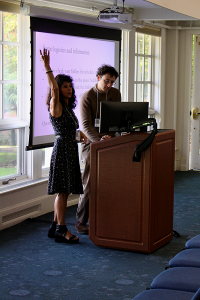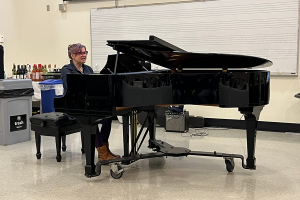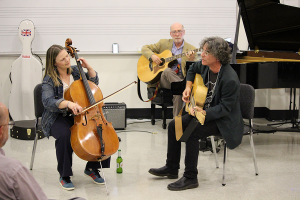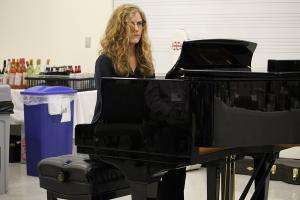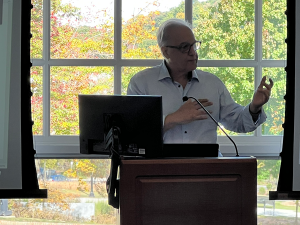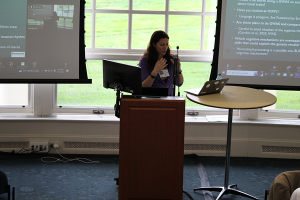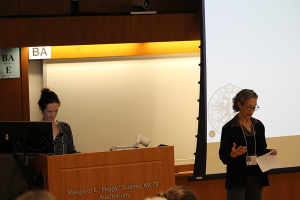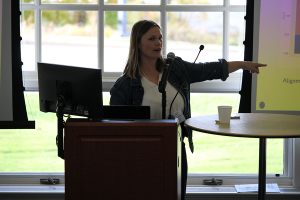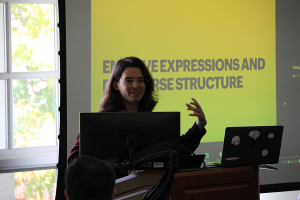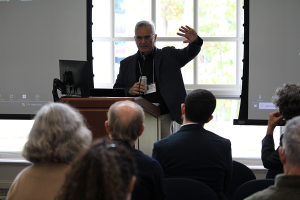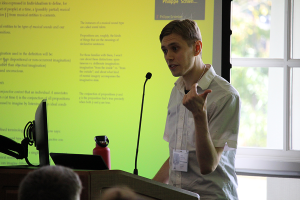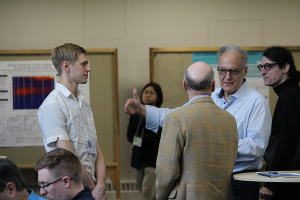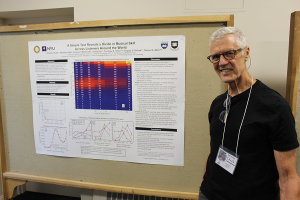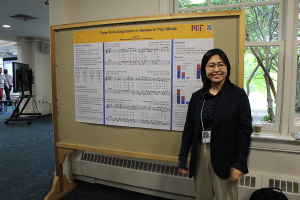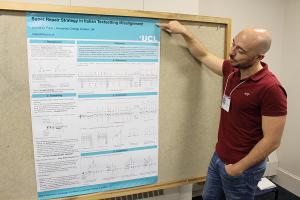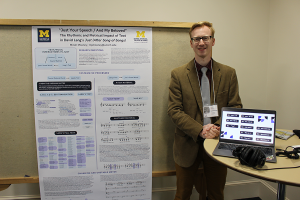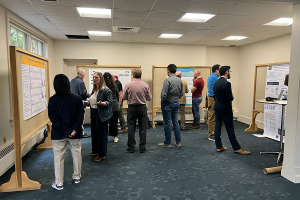The Expression, Communication, and Origins of Meaning (ECOM) research group hosted their second Expression, Language, and Music Conference (ELM2) this past weekend to rave reviews. This event brings together researchers from linguistics, music theory, anthropology, neurobiology, cognitive science, philosophy, and more, with the aim of integrating recent findings and insights from diverse perspectives concerning, e.g. the significance of emotional expression for both music and language, the importance of systematic structure in both music and language, and the interrelations between expressive, musical, and communicative capacities and their relevance for understanding the emergence of language (in ontogeny and phylogeny). Attendees came from around the globe, traveling from China, Switzerland, Germany, Canada, Iceland, and more.
Thank YOU for this very stimulating and really well organized conference! It was fun and inspiring.
-Isabelle Charnavel, Université de Genève
Reception
The first day of the conference concluded with a reception at the Zachs Family Fine Arts Administration Building. Attendees enjoyed lively discussion, fine fare, and a musical performance evening, organized by Stefanie Acevedo (UConn Music Theory; IBACS) featuring performers from among our conference participants.
We could not have asked for a better scholarly venue or confab of scholars – their input will prove invaluable. And it was really wonderful to hear and enjoy their music-making at the reception which was such a beautiful and unexpected bonus.
-Peter Kaminsky, UConn Music
Speakers
ELM2 featured an impressive line-up of invited and contributing speakers across a variety of disciplines. Keynotes included: Aniruddh Patel (Tufts, Psychology), Paul Boghossian (NYU, Philosophy), Isabelle Charnavel (Universite de Geneve, Linguistics), Reyna Gordon (Vanderbilt, Psychology), Eduardo Mercado (U at Buffalo, Psychology), Philippe Schlenker (NYU & Ecole Normale Superieure, Linguistics), and Alison Wray (Cardiff, Language and Linguistics).
Thanks for a stimulating conference. That was probably the most multidisciplinary conference I've ever been to...
-Elliott Moreton, UNC-Chapel Hill
A small sample of our talks:
Genomic discoveries shed new light on the biological underpinnings of human musicality and language
Reyna Gordon (Vanderbilt)
Studies of inter-individual differences in musical rhythm and language skills often show positive associations, even when the stimuli and tasks are quite different. Complementing neurocognitive explanations, in this talk I will focus on genomic approaches that are unraveling some of the shared variance between people's rhythm and language abilities. I will discuss the Musical Abilities, Pleiotropy, Language, and Environment (MAPLE) framework, and make a case that it will fill a key gap in our understanding of the etiology of individual differences in language acquisition and skill during the lifespan . We posit that musical and language-related abilities likely share some common genetic architecture (i.e., genetic pleiotropy) in addition to some degree of overlapping neural endophenotypes. I will present new genomic and epidemiological findings in support of MAPLE's predictions, revealing mechanistic underpinnings in the form of pleiotropy of rhythm and language traits and their downstream neurobiological processes influenced by that shared genetic variation.
Linking Music and Dance Perception: a Linguistics-based approach focused on Rhythm
Isabelle Charnavel (Université de Genève)
The specific goal of the talk is to apply the formal methodology of linguistics to the exploration of the interaction between music and dance rhythm perception based on specific case studies from the Western tradition. The more general goal is to shed further light on the organizational principles governing the mental representations induced by dance and music perception, as well as their relationship, by distinguishing between general cognitive properties and modality-specific or domain-specific properties
Phonological Rhythm Constrains Speech and Musical Gestures
Kathryn Franich (Harvard)
In many musical traditions, rhythmic aspects of spoken language interact with musical form. Theorists studying the music of West and Central Africa have alluded to the importance of spoken language rhythm in shaping musical form; however, little linguistic work has sought to understand the rhythmic properties of languages spoken in sub-Saharan Africa. I draw on patterns from 2 multi-modal corpora of language and gesture for speakers of Medʉmba and Igbo to demonstrate that rhythmic structure is not only a critical component of linguistic grammar for these languages, but also serves as a locus for coordination of linguistic and musical gesture.
Emotive Expressions and Discourse Structure
Christian De Leon (Williams)
Emotive expressions (including facial expressions, emotive markers, emoji, linguistic expressives, and emotional prosody) are classically analyzed as contributing content that is aside from the "main point" of an utterance—contributing not-at-issue content. I argue that emotive expressions enable a special kind of speech act that is unpredicted by standard views. I present data that show how an emotive makes a speaker's expressed attitude available for explanation, regardless of medium (e.g., prosody vs. written "damn") or whether the attitude makes sense in context. I develop a dynamic discourse semantics on which emotives make public commitments available for certain anaphoric relations.
Musical Neurodynamics
Ed Large (UConn)
A great deal of research in the neuroscience of music suggests that neural oscillations synchronize with musical stimuli. One well-known consequence of synchronization is expectation; however, neural synchronization has far-reaching implications for music. I will describe how fundamental dynamical principles based on known neural mechanisms can explain basic aspects of music perception and performance, as summarized in neural resonance theory (NRT). Building on principles such as resonance, stability, attunement, and strong anticipation, I suggest that people anticipate events not through predictive neural models, but because brain-body dynamics physically embody musical structure. The interaction of certain kinds of sounds with ongoing pattern-forming dynamics results in patterns of perception, action, and coordination that we collectively experience as music. Statistically universal structures may have arisen in music because they correspond to stable states of complex, pattern-forming dynamical systems. This analysis of empirical findings from the perspective of neurodynamic principles sheds new light on the neuroscience of music and on what makes music powerful.
The Metasemantics of Music
John Schindler (Pittsburgh)
Many believe that, in addition to expressing emotions, music represents extramusical ideas; however, there is scant philosophical literature discussing what it is for a piece of music to have a particular representational meaning—music’s metasemantics. To answer this question, I distinguish between a musical sound’s descriptive meaning—how it tends to be interpreted—and its normative meaning—how it ought, aesthetically speaking, to be interpreted. I reductively analyze both concepts in terms of hearing a sound as something else. I then argue against two alternative proposals; descriptive musical meaning can be analyzed neither in terms of resemblance nor in terms of musicians’ communicative intentions.
